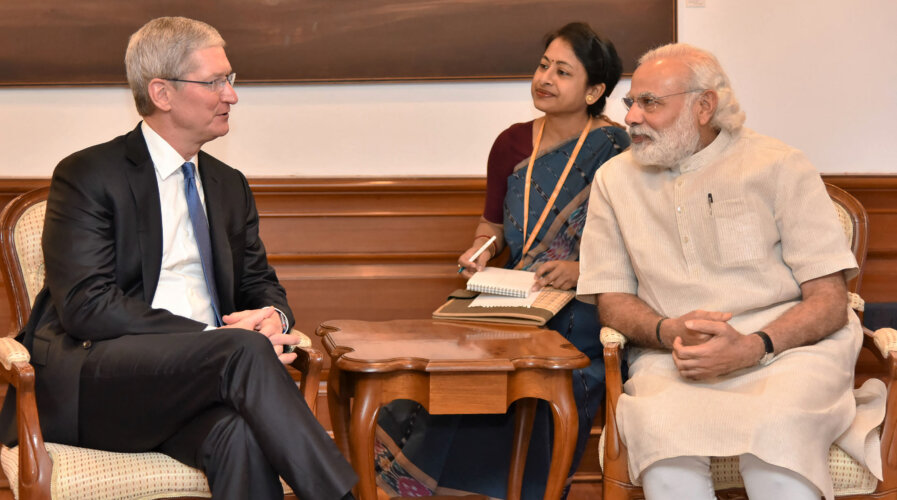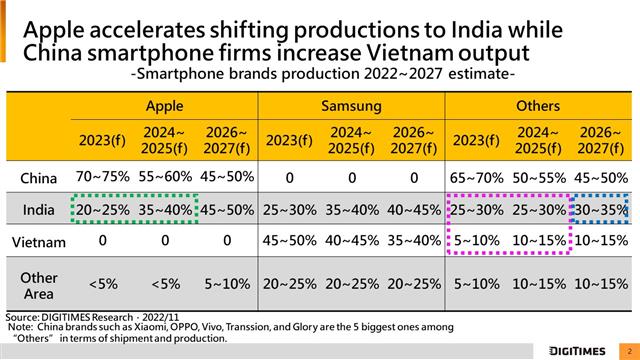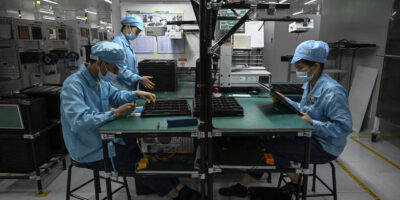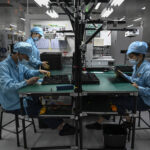
India is anticipated to produce 45-50% of Apple’s iPhones by 2027.(Photo by HO / PIB / AFP) / RESTRICTED TO EDITORIAL USE – MANDATORY CREDIT “AFP PHOTO / PIB” – NO MARKETING NO ADVERTISING CAMPAIGNS – DISTRIBUTED AS A SERVICE TO CLIENTS
India is anticipated to produce 45-50% of Apple’s iPhones by 2027
- Digitimes research analyst Luke Lin estimates India to produce 45-50% of Apple’s iPhones by 2027, on a par with China, where 80-85% of iPhones were produced in 2022.
- India’s assembly capacity accounted for 10-15% of iPhones’ overall production capacity at the end of 2022.
India and Vietnam have been in the center of Apple’s manufacturing and supply chain of late, especially since the maker of iPhones started diversifying out of China. A direct replacement for China isn’t on the cards yet, but partners of Apple like Foxconn and fellow Taiwanese assembler Pegatron Corp., have been putting foundations in place to handle more manufacturing and assembling capacity outside China.
When it comes to the assembly capacity of India, according to Digitimes research analyst Luke Lin, since 2022 it has accounted for 10-15% of iPhones’ overall production capacity. In contrast, the actual output in India has so far been less than 5%, because the trial production at Pegatron only started after September 2022, and Wistron’s production lines for Apple have not reached the maximum utilization rate.
However, Lin estimates that within the next five years India will produce 45-50% of Apple’s iPhones, on par with China, where 80-85% of iPhones were produced as of 2022. “The speed of supply chain migration to India will be accelerated in the future because of the need for diversifying risks in light of uncertainties of China’s pandemic control,” he said.
In the first half of 2022, Quanta, which accounts for 60-65% of MacBook’s production, was significantly hampered by the pandemic lockdown in Eastern China. In the second half of 2022, there were also pandemic control measures in Zhengzhou, which sparked a riot at a Foxconn plant there in November, affecting iPhone shipments.
When wages were increased in an attempt to tackle labor shortages, the cost of manufacturing in China rose. Therefore, Apple has been expanding its production capacity in India and Vietnam, as it seeks to better manage its supply chains amid pandemic uncertainties in China and geopolitical risks.
In fact, even two years before the US-China trade war erupted, Apple had asked Wistron to set up a factory in India. “At that time, the main focus was India’s big market,” said Lin, adding that since the local policy encourages local manufacturing, Apple wanted to gradually increase manufacturing in India. “They believe it will help local consumers to identify with its brand and help to expand its market share there.”
iPhones in India, iPads and MacBooks in Vietnam.
So far, Apple has accelerated its iPhone production shift to India and the iPad and MacBook to Vietnam. Goertek has been assembling AirPods for Apple in Vietnam since 2020. “Some Apple Watches will probably also be assembled outside China,” said Lin. But as Counterpoint senior analyst Ivan Lam noted, the one big hurdle for more production moving out of China is that the majority of iPhone components are still built there and have to be shipped to wherever devices are assembled.

Source – DIGITIMES Research estimates
On top of that, what India lacks is sound infrastructure, with most of suppliers still in China, meaning parts and components have to be imported from China, and making smartphones in India is costly. Despite having incentives in place following the escalation of the US-China trade war, it was the pandemic disruption of international logistics and domestic production that slowed the progress of manufacturing iPhones in India during 2020-2021.
Then Apple started reconsidering the risk of putting all its eggs in the same basket because of the China pandemic controls, so it is accelerating its supply chain migration to India, Lin highlighted. Apple is in the midst of its biggest India push with CEO Tim Cook being quite vocal about the South Asian nation being a key market for the company’s growth.
READ MORE
- 3 Steps to Successfully Automate Copilot for Microsoft 365 Implementation
- Trustworthy AI – the Promise of Enterprise-Friendly Generative Machine Learning with Dell and NVIDIA
- Strategies for Democratizing GenAI
- The criticality of endpoint management in cybersecurity and operations
- Ethical AI: The renewed importance of safeguarding data and customer privacy in Generative AI applications


